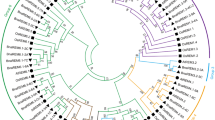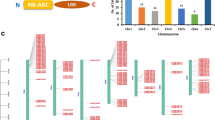Abstract
In the model species Arabidopsis thaliana, the floral homeotic C-class gene AGAMOUS (AG) specifies reproductive organ (stamen and carpels) identity and floral meristem determinacy. Gene function analyses in other core eudicots species reveal functional conservation, subfunctionalization and function switch of the C-lineage in this clade. To identify the possible roles of AG-like genes in regulating floral development in distylous species with dimorphic flowers (pin and thrum) and the C function evolution, we isolated and identified an AG ortholog from Fagopyrum esculentum (buckwheat, Family Polygonaceae), an early diverging species of core eudicots preceding the rosids-asterids split. Protein sequence alignment and phylogenetic analysis grouped FaesAG into the euAG lineage. Expression analysis suggested that FaesAG expressed exclusively in developing stamens and gynoecium of pin and thrum flowers. Moreover, FaesAG expression reached a high level in both pin and thrum flowers at the time when the stamens were undergoing rapidly increased in size and microspore mother cells were in meiosis. FaesAG was able to substitute for the endogenous AG gene in specifying stamen and carpel identity and in an Arabidopsis ag-1 mutant. Ectopic expression of FaesAG led to very early flowering, and produced a misshapen inflorescence and abnormal flowers in which sepals had converted into carpels and petals were converted to stamens. Our results confirmed establishment of the complete C-function of the AG orthologous gene preceding the rosids-asterids split, despite the distinct floral traits present in early- and late-diverging lineages of core eudicot angiosperms.
Similar content being viewed by others

References
Brockington SF, Alexandre R, Ramdial J, Moore MJ, Crawley S, Dhingra A, Hilu K, Soltis DE, Soltis PS (2009) Phylogeny of the Caryophyllales sensu lato: revisiting hypotheses on pollination biology and perianth differentiation in the core Caryophyllales. Int J Plant Sci 170:627–643
Cawoy V, Kinet JM, Jacquemart AL (2008) Morphology of nectaries and biology of nectar production in the distylous species Fagopyrum esculentum. Ann Bot 102:675–684
Clough SJ, Bent AF (1998) Floral dip: A simplified method for Agrobacterium-mediated transformation of Arabidopsis thaliana. Plant J 16:735–743
Coen ES, Meyerowitz EM (1991) The war of the whorls: genetic interactions controlling flower development. Nature 353:31–37
Davies B, Cartolano M, Schwarz-Sommer Z (2006) Flower development: The 3 perspective. Adv Bot Res 44:279–321
Davies B, Motte P, Keck E, Saedler H, Sommer H, Schwarz-Sommer Z (1999) PLENA and FARINELLI: redundancy and regulatory interactions between two Antirrhinum MADS-box factors controlling flower development. EMBO J 18:4023–4034
Dreni L, Kater MM (2014) MADS reloaded: evolution of the AGAMOUS subfamily genes. New Phytol 201:717–732
Dreni L, Pilatone A, Yun D, Erreni S, Pajoro A, Caporali E, Zhang D, Kater MM (2011) Functional analysis of all AGAMOUS subfamily members in rice reveals their roles in reproductive organ identity determination and meristem determinacy. Plant Cell 23:2850–2863
Endress PK (2006) Angiosperm floral evolution: Morphological developmental framework. Adv Bot Res 44:1–61
Fang ZW, Li XP, Li XF, Liu ZX (2015) FaesPI, a Fagopyrum esculentum PISTILLATA ortholog, is involved only in stamen development. J Plant Biol 58:102–109
Fourquin C, Ferrándiz C (2012) Functional analyses of AGAMOUS family members in Nicotiana benthamiana clarify the evolution of early and late roles of C-function genes in eudicots. Plant J 71:990–1001
Galimba KD, Di Stilio VS (2015) Sub-functionalization to ovule development following duplication of a floral organ identity gene. Dev Biol 405:158–172
Galimba KD, Tolkin TR, Sullivan AM, Melzer R, Theißen G, Di Stilio VS (2012) Loss of deeply conserved C-class floral homeotic gene function and C-and E-class protein interaction in a doubleflowered ranunculid mutant. Proc Natl Acad Sci USA 109:E2267–2275
Gimenez E, Castañeda L, Pineda B, Pan IL, Moreno V, Angosto T, Lozano R (2016) TOMATO AGAMOUS1 and ARLEQUIN/TOMATO AGAMOUS-LIKE1 MADS-box genes have redundant and divergent functions required for tomato reproductive development. Plant Mol Biol 91:513–531
Heijmans K, Ament K, Rijpkema AS, Zethof J, Wolters-Arts M, Gerats T, Vandenbussche M (2012) Redefining C and D in the petunia ABC. Plant Cell 24:2305–2317
Kitahara K, Hibino Y, Aida R, Matsumoto S (2004) Ectopic expression of the rose AGAMOUS-like MADS-box genes‘MASAKO C1 and D1’ cause similar homeotic transformation of sepal and petal in Arabidopsis and sepal in Torenia. Plant Sci 166:1245–1252
Kramer EM, Jaramillo MA, Di Stilio VS (2004) Patterns of gene duplication and functional evolution during the diversification of the AGAMOUS subfamily of MADS box genes in angiosperms. Genetics 166:1011–1023
Krizek BA, Fletcher JC (2005) Molecular mechanisms of flower development: an armchair guide. Nat Rev Genet 6:688–698
Liu Z, Zhang D, Liu D, Li F, Lu H (2013) Exon skipping of AGAMOUS homolog PrseAG in developing double flowers of Prunus lannesiana (Rosaceae). Plant Cell Rep 32:227–237
Lv S, Du X, Lu W, Chong K, Meng Z (2007) Two AGAMOUS-like MADS-box genes from Taihangia rupestris (Rosaceae) reveal independent trajectories in the evolution of class C and class D floral homeotic functions. Evol Dev 9:92–104
Ma H, de Pamphilis C (2000) The ABCs of floral evolution. Cell 101:5–8
Mizukami Y, Ma H (1992) Ectopic expression of the floral homeotic gene AGAMOUS in transgenic Arabidopsis plants alters floral organ identity. Cell 71:119–131
Murashige T, Skoog F (1962) A revied media for rapid growth and bioassay with tobacco cultures. Physiol Plant 15:473–497
Neff MM, Neff JD, Chory J, Pepper AE (1998) dCAPS, a simple technique for the genetic analysis of single nucleotide polymorphisms: experimental applications in Arabidopsis thaliana genetics. Plant J 14:387–392
ÓMaoiléidigh DS, Wuest SE, Rae L, Raganelli A, Ryan PT, Kwasniewska K, Das P, Lohan AJ, Loftus B, Graciet E, Wellmer F (2013) Control of reproductive floral organ identity specification in Arabidopsis by the C function regulator AGAMOUS. Plant Cell 25:2482–2503
Pan IL, McQuinn R, Giovannoni JJ, Irish VF (2010) Functional diversification of AGAMOUS lineage genes in regulating tomato flower and fruit development. J Exp Bot 61:1795–1806
Pelaz S, Ditta GS, Baumann E, Wisman E, Yanofsky MF (2000) B and C foral organ identity functions require SEPALLATA MADS-box genes. Nature 405:200–203
Riechmann JL, Krizek BA, Meyerowitz EM (1996) Dimerization specificity of Arabidopsis MADS domain homeotic proteins APETALA1, APETALA3, PISTILLATA, and AGAMOUS. Proc Natl Acad Sci USA. 93:4793–4798
Serwatowska J, Roque E, Gómez-Mena C, Constantin GD, Wen J, Mysore KS, Lund OS, Johansen E, Beltrán JP, Cañas LA (2014) Two euAGAMOUS genes control C-function in Medicago truncatula. PLoS One 9:e103770
Tamura K, Peterson D, Peterson N, Stecher G, Nei M, Kumar S (2011) MEGA5: molecular evolutionary genetics analysis using maximum likelihood, evolutionary distance, and maximum parsimony methods. Mol Biol Evol 28: 2731–2739
Tanaka Y, Oshima Y, Yamamura T, Sugiyama M, Mitsuda N, Ohtsubo N, Ohme-Takagi M, Terakawa T (2013) Multi-petal cyclamen flowers produced by AGAMOUS chimeric repressor expression. Sci Rep 3:2641
Tanaka Y, Yamamura T, Terakawa T (2011) Identification and expression analysis of the Cyclamen persicum MADS-box gene family. Plant Biotechnol 28:167–172
Wang P, Liao H, Zhang W, Yu X, Zhang R, Shan H, Duan X, Yao X, Kong H (2015) Flexibility in the structure of spiral flowers and its underlying mechanisms. Nat Plants 2:15188
Yan W, Chen D, Kaufmann K (2016) Molecular mechanisms of floral organ specification by MADS domain proteins. Curr Opin Plant Biol 29:154–62
Yang Y, Jack T (2004) Defining subdomains of the K domain important for protein-protein interactions of plant MADS proteins. Plant Mol Biol 55:45–59
Zahn LM, Feng BM, Ma H (2006) Beyond the ABC-Model: Regulation of floral homeotic genes. Adv Bot Res 44:164–196
Zhang B, Liu ZX, Ma J, Song Y, Chen FJ (2015) Alternative splicing of the AGAMOUS orthologous gene in double flower of Magnolia stellata (Magnoliaceae). Plant Sci 241:277–285
Author information
Authors and Affiliations
Corresponding author
Additional information
These authors contributed equally to the present work.
Rights and permissions
About this article
Cite this article
Li, LY., Fang, ZW., Li, XF. et al. Isolation and characterization of the C-class MADS-box gene from the distylous pseudo-cereal Fagopyrum esculentum . J. Plant Biol. 60, 189–198 (2017). https://doi.org/10.1007/s12374-016-0488-3
Received:
Accepted:
Published:
Issue Date:
DOI: https://doi.org/10.1007/s12374-016-0488-3



